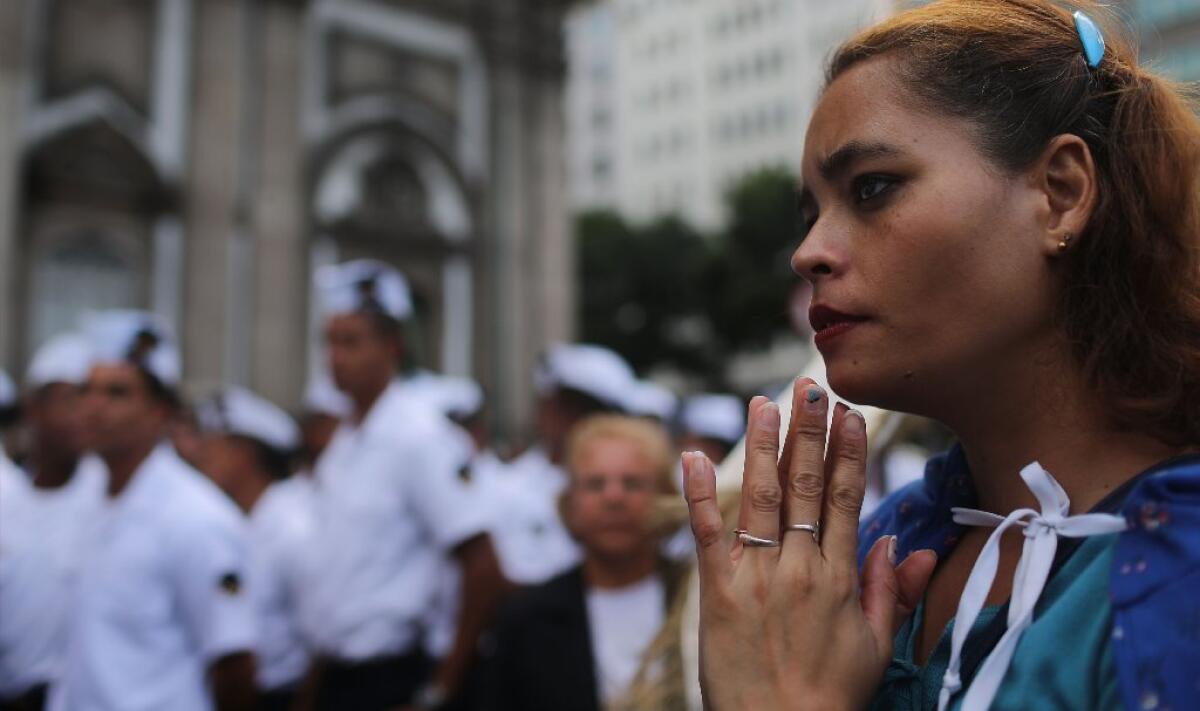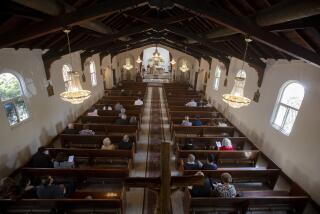Church attendance linked with reduced suicide risk, especially for Catholics, study says

- Share via
Against a grim backdrop of rising suicide rates among American women, new research has revealed a blinding shaft of light: One group of women — practicing Catholics — appears to have bucked the national trend toward despair and self-harm.
Compared with women who never participated in religious services, women who attended any religious service once a week or more were five times less likely to commit suicide between 1996 and 2010, says a study published Wednesday by JAMA Psychiatry.
It’s not clear how widely the findings can be applied to a diverse population of American women. In a study population made up of nurses and dominated by women who identified themselves as either Catholic or Protestant, the suicide rate observed was about half that for U.S. women as a whole. Of 89,708 participants aged 30 to 55, 36 committed suicide at some point over 15 years.
See the most-read stories in Science this hour »
The women’s church attendance was not the only factor; which church they attended mattered as well. Protestant women who worshiped weekly at church were far less likely to take their own lives than were women who seldom or never attended services. But these same Protestant women were still seven times more likely to die by their own hand than were their devout Catholic sisters.
Among especially devout Catholic women — those in the pews more than once a week — suicides were a vanishing phenomenon. Among the 6,999 Catholic women who said they attended mass more than once a week, there was not a single suicide.
The suicide-prevention effect of religion was clearly not a simple matter of group identity: Self-identified Catholics who never attended mass committed suicide nearly as often as did women of any religion who were not active worshipers.
Instead, the authors suggested that attendance at religious services is “a form of meaningful social participation” that buffers women against loneliness and isolation — both factors that are strongly implicated in depression and suicide. “Religion and spirituality may be an underappreciated resource that psychiatrists and clinicians could explore with their patients, as appropriate,” wrote a team of researchers led by Tyler J. VanderWeele of Harvard’s T.H. Chan School of Public Health.
The new study comes just two months after the Centers for Disease Control and Prevention documented a steep rise in suicides in the United States between 1994 and 2014. Suicide rates climbed among men and women and in all age groups between 10 and 74. Although women remain much less likely than men to commit suicide, the CDC found that gap closing. Among women between 45 and 64 — the ages at which women are most likely to kill themselves — the rate of suicide in 2014 vaulted 80% over 1999’s rates.
The Catholic Church teaches that suicide is a mortal sin. It has long warned that those who killed themselves would go to hell, and denied those who killed themselves a Catholic burial.
In recent decades, however, the church’s pronouncements have softened. Catholic teaching now asserts that a suicide victim’s responsibility can be diminished by “grave psychological disturbances, anguish or grave fear of hardship, suffering or torture.” And it cautions that families “should not despair of the eternal salvation” of a loved one who has taken his or her own life.
Though stern prohibitions against suicide might have led to its under-reporting by Catholic next-of-kin, the authors of the new research say that such misrepresentation would have had to be perpetrated on a massive scale to erase the stark difference they found between church-going women — and Catholic church-goers in particular — and their nonreligious peers.
Sigmund Freud, the father of psychiatry, denounced religious belief as the “universal obsessional neurosis of humanity.” Much current research, however, has focused not only on the deep biological underpinnings of religiosity, but its potential benefits as well.
Dr. Aaron Kheriaty, associate professor of psychiatry at UC Irvine, said the new study’s design and its findings strengthen a link between religious practice and mental health that was first explored by the sociologist Emile Durkheim in 1897.
The lengthy duration of the current study — women were asked about their religious attendance every two years starting in 1996 and then followed until 2010 — “suggests a causal relationship between religious practice and a significantly lower risk of suicide, especially among Catholics,” said Kheriaty, who was not involved with the new research.
Kheriaty, who is co-author of “The Catholic Guide to Depression,” acknowledged the power of strong religious proscriptions against suicide. But, he added, religion may protect against despair as well.
“Religious convictions and practices can help people foster a sense of hope, even in the midst of major crises or adversities,” said Kheriaty. “Religious faith can help people find a sense of meaning and purpose even in suffering,” he added.
“It’s not our role to ‘prescribe’ religion… or proselytize to our patients,” said Kheriaty. “It is safe to assume that religious conviction and faith must be genuine and sincere if they are to provide the mental and physical health benefits that several studies have suggested.”
But if patients are inclined to explore religion or spirituality, said Kheriaty, “doctors can encourage patients to explore such activities confident that religious practices will likely not harm, and may indeed, help, their patient’s mental health.”
Follow me on Twitter @LATMelissaHealy and “like” Los Angeles Times Science & Health on Facebook.
MORE IN SCIENCE
Scientists swab microbes in Boston’s subway system for early signs of antibiotic resistance
Scientists take big step closer to creating not one but two vaccines against Zika
British scientists are freaking out about ‘Brexit’ too
Lead exposure soared after kids in Flint started drinking tainted water, CDC says







